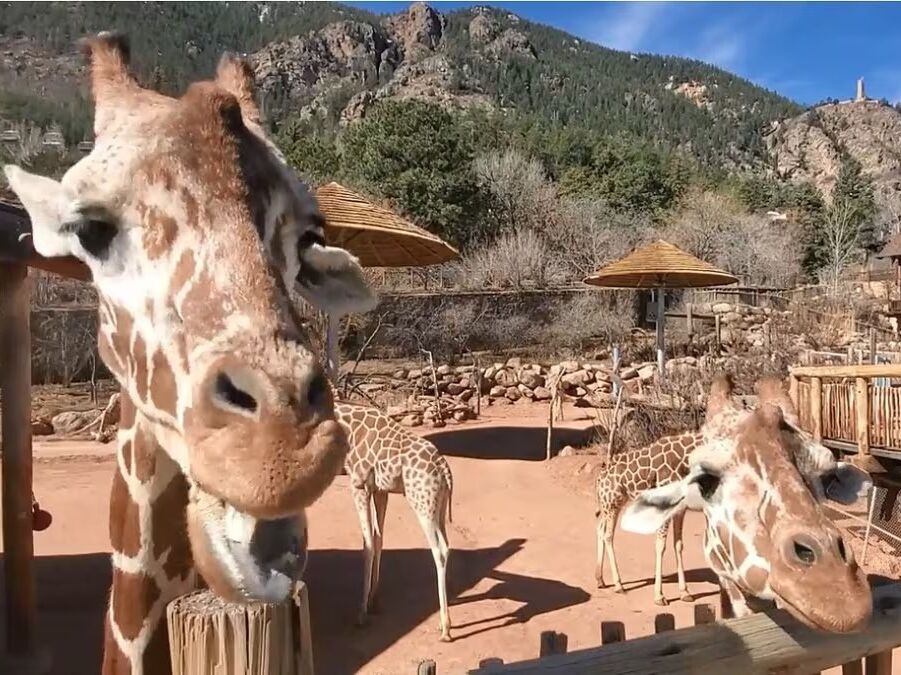Jillian & Brandon
Jillian & Brandon
Adventure in Colorado Springs
Garden of the Gods
Description:
The Garden of the Gods is a National Natural Landmark and a popular destination for nature lovers, hikers, and photographers. The park covers around 1,367 acres and features towering sandstone rock formations that create a unique and picturesque landscape. Some of the prominent formations include the Balanced Rock, Kissing Camels, and Three Graces. The contrast of the red rocks against the blue sky and the surrounding greenery is a sight to behold.
Activities:
Hiking and Nature Trails: The park offers a variety of hiking trails, ranging from easy walks to more challenging hikes. Trails such as the Perkins Central Garden Trail and the Siamese Twins Trail provide different perspectives of the rock formations.
Rock Climbing: For those seeking adventure, Garden of the Gods offers opportunities for rock climbing. Certain areas are designated for climbing, and climbers should be experienced and follow safety guidelines.
Photography: The unique and stunning rock formations make the Garden of the Gods a paradise for photographers. Sunrise and sunset are particularly magical times to capture the beauty of the park.
Visitor Center: The Garden of the Gods Visitor & Nature Center is an excellent starting point for your visit. It provides information about the park's geology, flora, and fauna. There are also educational exhibits, a gift shop, and helpful staff to answer any questions.
Scenic Drives: If you prefer a more relaxed experience, you can drive through the park and enjoy the scenery from the comfort of your car. The park has a one-way loop that takes you past many of the major rock formations.
Guided Nature Walks and Programs: The park sometimes offers guided walks and educational programs conducted by naturalists. These programs provide insights into the geology, ecology, and history of the Garden of the Gods.
Picnicking: There are designated picnic areas within the park where you can relax and enjoy a meal surrounded by the breathtaking landscape.
Before planning your visit, it is advisable to check for any updates on park regulations, trail conditions, and possible new activities or programs.
Always prioritize safety and respect the natural environment when exploring Garden of the Gods or any natural area.
Manitou Springs Heritage Center and Museum
Manitou Springs is a charming town located at the base of Pikes Peak in Colorado, USA. Known for its picturesque setting, unique shops, and historical attractions, Manitou Springs offers visitors a delightful blend of natural beauty and cultural experiences. Here's a description of the town and some activities you can enjoy there:
Description:
Scenic Beauty:
Nestled in the foothills of the Rocky Mountains, Manitou Springs boasts stunning views of Pikes Peak and the surrounding landscapes. The town is surrounded by natural wonders, including the Garden of the Gods, a breathtaking red rock formation, and the Manitou Incline, a challenging hiking trail with panoramic views.
Historic Charm:
Manitou Springs has a rich history dating back to the 19th century. Victorian-style architecture and historic buildings line the streets, giving the town a unique and nostalgic atmosphere. The historic district offers a chance to explore the past with well-preserved buildings and informative plaques.
Mineral Springs:
Manitou Springs is famous for its natural mineral springs. Visitors can enjoy a stroll through the town and taste the mineral-rich waters from various fountains.
The healing properties of these springs have attracted people for centuries, and many believe in their therapeutic benefits.
Unique Shops and Art Galleries:
The town is home to a variety of eclectic shops, boutiques, and art galleries. Visitors can explore local craftsmanship, unique souvenirs, and one-of-a-kind artworks. The shopping district reflects the artistic and creative spirit of Manitou Springs.
Activities:
Pikes Peak Cog Railway:
Take a scenic ride on the Pikes Peak Cog Railway to the summit of Pikes Peak. The journey offers breathtaking views, and the summit provides an unparalleled panorama of the region.
Manitou Incline:
Challenge yourself with a hike up the Manitou Incline, a steep and strenuous trail with an elevation gain of over 2,000 feet. The reward is a spectacular view of the surrounding mountains.
Cave of the Winds:
Visit the Cave of the Winds to experience underground wonders. Guided cave tours provide insight into the geological formations, and there are also above-ground attractions like zip lines and adventure courses.
Festivals and Events:
Check the local events calendar for festivals and events that may be happening during your visit. Manitou Springs hosts various events throughout the year, including art festivals, parades, and cultural celebrations.
Whether you're interested in outdoor adventures, cultural experiences, or simply enjoying the scenic beauty of the area, Manitou Springs offers a diverse range of activities for visitors of all interests.
Cheyenne Mountain Zoo
Cheyenne Mountain Zoo Overview:
The Cheyenne Mountain Zoo is unique because it is situated at an elevation of 6,714 feet (2,046 meters) above sea level, making it one of the highest zoos in the world. The zoo is known for its stunning mountainous setting and its commitment to conservation, education, and animal care.
Key Features and Activities:
Animal Exhibits:
The zoo houses over 750 animals representing approximately 170 species, including endangered and rare species. Exhibits are designed to mimic natural habitats and provide enriching environments for the animals.
Encounters and Demonstrations:
Some zoos offer special animal encounters or demonstrations, where visitors can get up close and personal with certain animals while learning about their behaviors and conservation.
Giraffe Feeding:
One popular activity at the Cheyenne Mountain Zoo is the opportunity to feed giraffes. Visitors can purchase special giraffe feeding tickets for an extra fee.
Scenic Overlooks:
Due to its elevated location, the zoo offers stunning views of Colorado Springs and the surrounding mountains. There are scenic overlooks where visitors can take in the picturesque landscape.
Conservation and Education Programs:
The Cheyenne Mountain Zoo is actively involved in conservation efforts and has educational programs aimed at raising awareness about wildlife and habitat conservation.
Events and Special Programs:
The zoo often hosts special events, such as seasonal celebrations, educational workshops, and family-friendly activities. Check the zoo's calendar for any upcoming events during your visit.
Dining and Shopping:
The zoo typically has dining options where visitors can grab a bite to eat. There might also be gift shops offering souvenirs and educational materials.
Minor League Baseball Game
The Rocky Mountain Vibes are an independent baseball team of the Pioneer League, an MLB Partner League. They play their home games at UCHealth Park.
The Vibes have games on:
Friday, July 19th at 6:35 PM
Sunday, July 21st at 6:35 PM
Games are low cost fun experience. Tickets are around $20.
National Museum of World War II Aviation
The National Museum of World War II Aviation is dedicated to preserving and showcasing the history of aviation during World War II. Here's a general description of what you might expect and what to do when visiting:
Overview:
Exhibits: The museum features a collection of aircraft, artifacts, and exhibits related to World War II aviation. You can explore a variety of planes, learn about the technology, and understand the role of aviation during this significant period in history.
Educational Displays: Expect to find educational displays that provide context and historical information about the aircraft, the pilots, and the wartime era. The museum aims to educate visitors about the important role aviation played in World War II.
Interactive Experiences: Some museums offer interactive displays or simulators, allowing visitors to get a hands-on experience of flying or operating World War II-era aircraft.
Guided Tours: Many museums offer guided tours led by knowledgeable docents who provide in-depth information about the exhibits, the history of the aircraft, and the stories of the people involved.
What to Do:
Explore the Exhibits: Take your time exploring the various aircraft and exhibits. Read the information provided to gain a better understanding of the historical context and significance of each display.
Attend Talks or Presentations: Check the schedule for any talks or presentations that might be happening during your visit. These events can provide additional insights into specific aspects of World War II aviation.
Participate in Interactive Activities: If the museum offers interactive activities or simulators, take advantage of them to get a feel for what it was like to be a pilot during World War II.
Ask Questions: Don't hesitate to ask museum staff or volunteers if you have any questions. They are often passionate about the subject and can provide valuable information.
Visit the Gift Shop: Many museums have a gift shop where you can purchase memorabilia, books, and other items related to World War II aviation. It's a good way to support the museum and take home a memento of your visit.
The Broadmoor
The Broadmoor today continues to be one of the nation's most prestigious historic destinations. A walk around the lake and hotel grounds provides a delightful stroll past the outdoor swimming pool and resident ducks, geese, and swans, multiple shops and eateries. Truly stunning!





